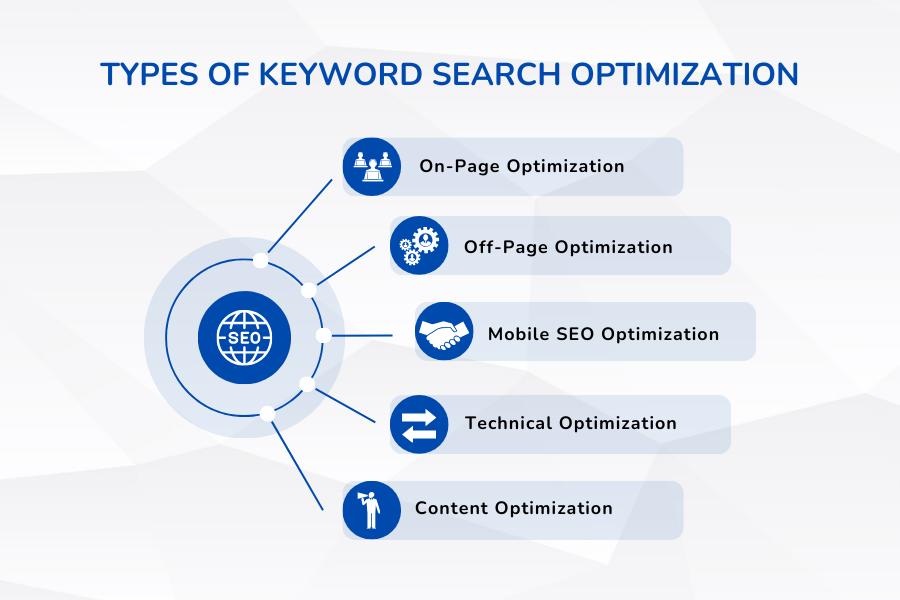Table of Content
For every kind of a web page, it has never been more critical in order to attain the best visibility on search engines. There are several methods that have been considered very beneficial in enhancing the website’s ranking, but perhaps one stands out from the rest – strategic keyword Search optimization. Here, though, is an inclusive guide that takes one through all they have to learn about correct keywording strategies for their site.
What Is Keyword Search Optimization?
Making changes to your content so that it can be easily found on search engines is keyword search optimization. This means that it entails selecting particular terms which individuals are likely to use while searching for services or products in different search engines. It is important because it makes sure that your content responds to what your target audience is looking for in terms of information. Effectively optimize your keywords, and you better the odds of ranking higher in search results, get more people visiting your website and be able to connect well with your target audience that is in mind.
Why Is Keyword Search Optimization Important?
Keyword search optimization is crucial for several reasons. Here are five key points:
- Improved Visibility: Optimizing for the right keywords helps your content appear in search engine results pages (SERPs) when users search for relevant terms. This increases the chances of your content being seen by a broader audience.
- Higher Quality Traffic: By targeting specific, relevant keywords, you attract users who are genuinely interested in your content or products. This leads to higher engagement and better conversion rates, as the traffic is more likely to consist of potential customers or engaged readers.
- Competitive Advantage: Effective keyword search optimization allows you to outperform competitors who may not be using targeted keywords as effectively. This can help you capture a larger share of the market or audience within your niche.
- Better User Experience: When your content matches what users are searching for, it enhances their experience. Providing relevant information quickly and efficiently keeps users satisfied and more likely to return to your site.
- Increased ROI: Keyword search optimization can lead to better placement in search results without the need for extensive advertising spend. This organic reach can result in a higher return on investment (ROI) compared to other marketing strategies, making it a cost-effective way to grow your audience and customer base.
Elements of Keyword Research
Keyword research is a fundamental aspect of search engine optimization (SEO) and involves several key elements:
- Identifying Seed Keywords: Seed keywords are the starting point of your keyword research. These are broad terms related to your niche, industry, or topic that you can use to generate more specific keywords.
- Analyzing Search Volume: This involves determining how often particular keywords are searched for on search engines. High search volume indicates a popular keyword, but it might also mean more competition.
- Assessing Keyword Difficulty: Also known as keyword competition, this element measures how difficult it is to rank for a specific keyword. Tools often provide a difficulty score to help you gauge the competitiveness of the keyword.
- Evaluating Relevance: It’s essential to ensure that the keywords you choose are relevant to your content, products, or services. Irrelevant keywords, even if they have high search volumes, will not drive meaningful traffic to your site.
- Considering Long-Tail Keywords: Long-tail keywords are longer, more specific phrases that typically have lower search volumes but higher conversion rates. They often represent more intent-driven searches and can be easier to rank for compared to broader terms.
- Analyzing Competitors: Reviewing the keywords your competitors are targeting can provide insights into what is working in your industry. This can help you identify gaps and opportunities for your own keyword strategy.
- Tracking Trends and Seasonality: Understanding how keyword popularity changes over time can help you optimize your content for peak search times. Some keywords may be highly seasonal, while others might show trends of increasing or decreasing interest.
- Utilizing Keyword Tools: Tools like Google Keyword Planner, Ahrefs, SEMrush, and others provide valuable data on search volume, competition, and related keywords, making the research process more efficient and accurate.
- User Intent Analysis: It’s crucial to understand the intent behind keyword searches—whether users are looking for information, trying to make a purchase, or seeking a specific site. Matching your keywords to the correct intent ensures that your content meets users’ needs.
- Local Keywords: For businesses targeting local customers, incorporating location-specific keywords can help attract nearby users searching for services or products in their area.
Types of Keyword Search Optimization
Keyword search optimization can be categorized into several types based on the specific strategies and goals involved. Here are the primary types:

On-Page Optimization:
- Content Keywords: Integrating relevant keywords naturally into the content of your pages, such as blog posts, product descriptions, and landing pages.
- Meta Tags: Including keywords in meta titles, meta descriptions, and meta keywords when performing on-page SEO to help search engines understand the content of your pages.
- Headings and Subheadings: Using keywords in H1, H2, and other heading tags to structure your content and signal its relevance to search engines.
- URL Structure: Creating SEO-friendly URLs that include relevant keywords.
Off-Page Optimization:
- Backlinks: Acquiring high-quality backlinks from other websites is important for off-Page SEO that include keywords in the anchor text, helping to boost your site’s authority and relevance.
- Social Media: Using keywords in your social media profiles, posts, and hashtags to improve visibility and drive traffic from social platforms.
Local SEO Optimization:
- Local Keywords: Targeting keywords that include geographic locations to attract local customers.
- Google My Business: Optimizing your Google My Business profile with relevant local keywords to enhance local SEO.
- Citations: Ensuring your business name, address, and phone number (NAP) are consistent and include keywords across all local directories.
Mobile SEO Optimization:
- Mobile-Friendly Keywords: Focusing on shorter, more conversational keywords that mobile users are likely to use.
- Voice Search Optimization: Adapting to the rise of voice search by targeting long-tail keywords and natural language queries.
E-commerce Optimization:
- Product Keywords: Using specific product-related keywords in titles, descriptions, and tags to improve the visibility of individual products.
- Category Keywords: Optimizing category pages with relevant keywords to help users find related products.
Technical SEO Optimization:
- Site Speed: Ensuring your website loads quickly, which can improve search rankings and user experience.
- Mobile Optimization: Making sure your site is mobile-friendly, as search engines prioritize mobile-optimized content.
- Structured Data: Putting schema _ markup in place to help search engines understand and display your content is more effective.
Content Optimization:
- Topic Clusters: Creating content around core topics and subtopics to enhance keyword relevance and site structure.
- Content Refreshing: Regularly updating existing content with new keywords and information to maintain its relevance and rankings.
User Intent Optimization:
- Informational Keywords: Targeting keywords that users search for when looking for information or answers to questions.
- Transactional Keywords: Focusing on keywords that indicate a user’s intent to make a purchase or complete a transaction.
- Navigational Keywords: Optimizing for keywords that users use to find a specific website or page.
By implementing these different types of keyword search optimization strategies, you can improve your website’s search engine rankings, attract more relevant traffic, and enhance overall user experience.
How to Find and Choose Keywords for Your Website?
Finding and choosing the right keywords for your website involves a structured approach. Here are the key steps to follow:
Understand Your Niche:
- Identify Your Target Audience: Determine who your ideal customers or readers are, their interests, needs, and how they might search for content or products related to your niche.
- Analyze Competitors: Study your competitors’ websites and find out which keywords they are targeting. Tools like Ahrefs or SEMrush can help you identify competitors’ keywords.
Brainstorm Seed Keywords:
- List Core Topics: Think about the main topics related to your business or website. These are known as well as can be more specified keywords.
- Customer Input: Ask your customers or audience what terms they would use to search for your products or services.
Use Keyword Research Tools:
- Google Keyword Planner: Google Keyword Planner gives search volume, competition as well as suggestions on the keywords.
- Ahrefs, SEMrush, Moz: Offer comprehensive keyword analysis, including search volume, keyword difficulty, and competitor analysis.
- AnswerThePublic: Generates keyword ideas based on common questions and queries related to your seed keywords.
- Ubersuggest: Offers keyword suggestions, search volume, and competition analysis.
Analyze Keyword Metrics:
- Search Volume: How often a keyword is searched for in a given timeframe. High search volume indicates popular keywords, but they may also be highly competitive.
- Keyword Difficulty: Keyword difficulty depicts the extent at which you need to apply extra efforts so as to gain a higher rank for a given keyword. Try to identify keywords that have lower search traffic estimates and a moderate level of competition.
- Cost-Per-Click (CPC): If you’re considering paid search, CPC indicates how much advertisers are willing to pay for a click on their ads. High CPC can imply high commercial intent.
Consider User Intent:
- Informational Keywords: Used by users looking for information. Examples include “how to,” “best ways to,” etc.
- Navigational Keywords: Navigation keywords are used when a person is looking for a particular web site or page.
- Transactional Keywords: Used when users are ready to make a purchase. These often include words like “buy,” “discount,” “deal,” etc.
- Commercial Investigation Keywords: Used when users are comparing products or services. Examples include “best,” “reviews,” “comparison,” etc.
Create a Keyword List:
- Primary Keywords: High-volume, high-relevance keywords that are central to your content.
- Secondary Keywords: Related keywords that support the primary keywords and can be naturally integrated into your content.
- Long-Tail Keywords: Long tail keywords are longer specific phrases that may be used less often in search engines but they result in more conversions when they are used.
Refine and Prioritize:
- Relevance: Ensure the keywords you choose are highly relevant to your content or products.
- Search Volume vs. Competition: Balance between keywords with high search volume and those that are less competitive.
- Trends and Seasonality: Consider how keyword popularity changes over time and if there are seasonal trends.
Implement Keywords Strategically:
- Content: Naturally incorporate keywords into your page content, headings, and subheadings.
- Meta Tags: Use keywords in meta titles, descriptions, and alt text for images.
- URLs: For SEO friendly URLs make sure you include the keyword in your URL structure.
- Internal Links: Use keywords in anchor text for internal links to help with site navigation and SEO.
By following these steps, you can find and choose keywords that will help to improve website ranking, attract relevant traffic, and ultimately achieve your business or content goals.
How to Improve Website Ranking with Right Keyword Strategies?
Improving your website’s ranking with effective keyword strategies involves a combination of planning, implementation, and ongoing optimization. Here’s a step-by-step guide to help you boost your rankings:
Conduct Thorough Keyword Research:
- Identify Relevant Keywords: Use tools like Google Keyword Planner, Ahrefs, or SEMrush to find keywords that are relevant to your niche and have a good balance of search volume and competition.
- Understand User Intent: Choose keywords that align with what users are searching for, whether they’re looking for information, products, or services.
Optimize On-Page Elements:
- Title Tags: Ensure that with title tags you have this primary keyword added and ensure that they remain appealing while maintaining relevance with description of content on that page.
- Meta Descriptions: Write descriptive meta descriptions with keywords to encourage clicks from search results.
- Headings and Subheadings: Use keywords in headings (H1, H2, H3) to structure your content and signal its relevance to search engines.
- Content: Naturally incorporate keywords into your content. Avoid keyword stuffing by focusing on readability and user experience.
- URL Structure: Create SEO-friendly URLs that include primary keywords and are easy to understand.
Develop High-Quality Content:
- Create Valuable Content: Focus on producing content that answers users’ questions, solves their problems, and provides in-depth information related to your keywords.
- Use Keywords Strategically: Integrate keywords into your content in a way that feels natural and adds value. Use related terms and synonyms to avoid redundancy.
Build Backlinks:
- Acquire Quality Backlinks: Obtain backlinks from reputable and relevant websites. You can see how much improvement link building causes on search engine rankings.
- Guest Blogging: Write guest posts for other websites in your industry and include links back to your site.
- Create Shareable Content: Develop content that others are likely to share or link to, such as infographics, research reports, or industry guides.
Optimize for User Experience:
- Site Speed: Ensure your website loads quickly, as page speed is a factor in search rankings and user satisfaction.
- Mobile-Friendliness: Make sure your site is optimized for mobile devices, as mobile-friendliness is crucial for both ranking and user experience.
- Navigation and Structure: Design a clear and intuitive site structure to help users find what they’re looking for and keep them engaged.
Local SEO:
- Local Keywords: Incorporate location-specific keywords if you’re targeting local customers.
- Google My Business: Optimize and regularly update your Google My Business profile to enhance local search visibility.
- Local Citations: Ensure consistency in your business name, address, and phone number (NAP) across all local directories and listings.
Monitor and Analyze Performance:
- Track Rankings: Use tools like Google Search Console or Ahrefs to monitor keyword rankings and track changes over time.
- Analyze Traffic: Review traffic data to understand which keywords are driving visitors to your site and how well they’re converting.
- Adjust Strategies: Based on performance data, adjust your keyword strategy to focus on high-performing keywords and improve areas where results are lacking.
Stay Updated with SEO Trends:
- Algorithm Changes: Keep up with changes in search engine algorithms and adjust your strategies accordingly.
- Emerging Trends: Stay informed about new SEO trends and technologies, such as voice search optimization and artificial intelligence.
By following these strategies, you can effectively improve your website’s ranking, drive more relevant traffic, and achieve better overall performance in search engine results.
Conclusion
Keyword search optimization is a continuous process that requires research, analysis, and strategic implementation. By focusing on relevant keywords and optimizing your website’s content effectively, you can enhance its visibility, attract more visitors, and achieve your online goals. Remember, understanding your audience’s search behavior and providing valuable content is key to sustainable search engine success.
Frequently Asked Questions
Keyword cannibalization occurs when multiple pages on a website target the same keyword, potentially diluting the SEO strength of each page. It's important to consolidate or differentiate keywords to avoid this issue.
Keywords should be regularly reviewed and updated based on changes in search trends, user behavior, and updates to your content strategy. Aim for periodic audits to ensure relevance.
Absolutely! Local SEO relies heavily on keyword optimization to attract nearby customers. Focusing on keywords that mention your location can help more people in your area find your business in search results.
Semantic keywords are related terms and phrases that help search engines understand the context of your content. Integrating these naturally can improve relevance and user experience.
Voice search often uses longer, conversational queries. Optimizing for natural language and question-based keywords can enhance visibility in voice search results.
Both types have their advantages. Short-tail keywords have higher search volumes but also higher competition, while long-tail keywords are more specific and can attract more qualified traffic.
When naming files use descriptions and alt tags that contain keywords that seem applicable. This way, it is easier for search engines to understand the content of your images hence improving your Search Engine Optimization (SEO) efforts.
Sharing content that includes targeted keywords on social media can increase visibility and drive traffic to your website, indirectly benefiting SEO efforts.







